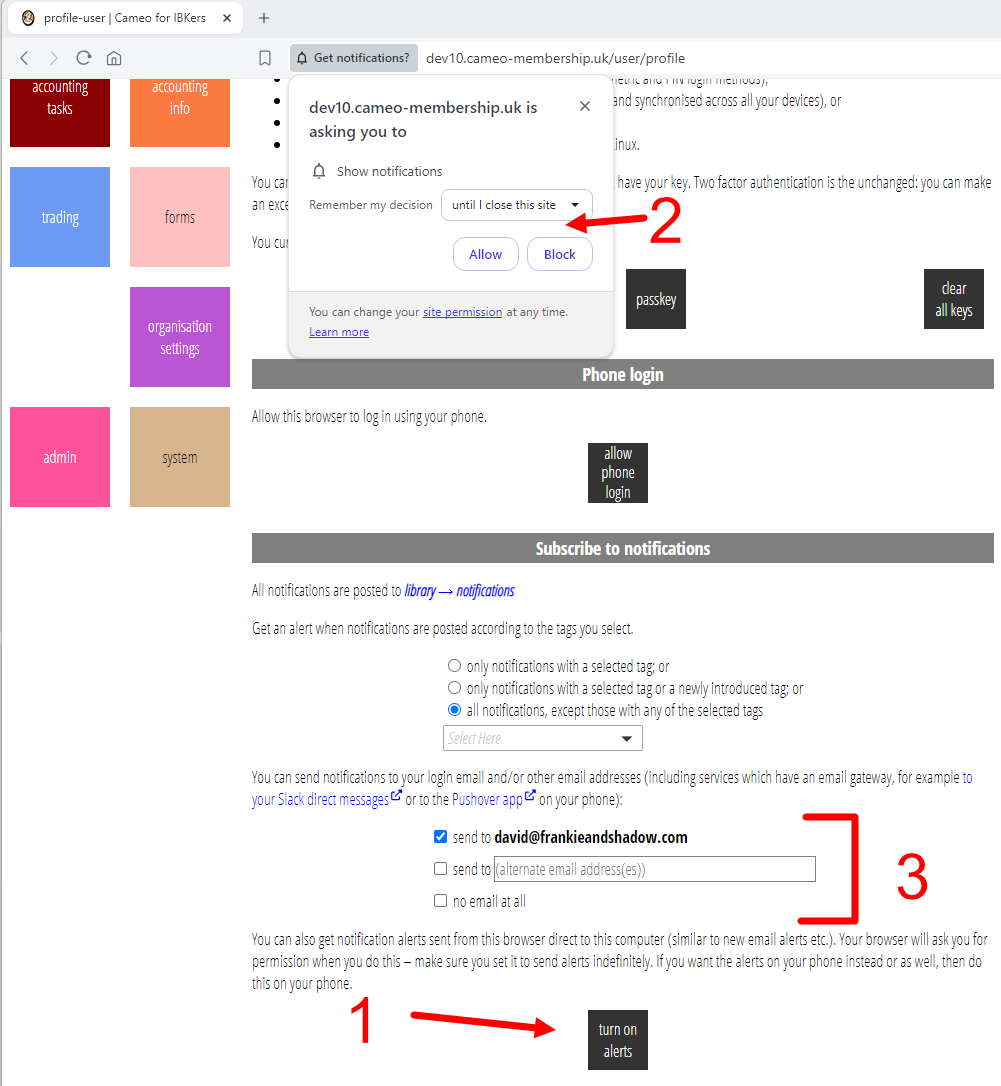You can now ask Cameo to send its notifications to the computer’s notification area. These are quite short: we show a truncated version of the whole notification. When you click on a notification alert, it takes you to Cameo’s notifications section to see it all. All notifications are posted to library → notifications in full.
Each browser and platform behaves a little differently. The simplest is probably Chrome on Windows. The most useful is probably on a phone.
Contents
Background
You’ll be familiar with system notifications. Many apps use them to alert you to all sorts of things. For example, email apps may pop up a message for a new email arriving. You’ll be less familiar with how these work. While a running app can pop up a message, most of the time the reason for the alert isn’t in the app at all, but on the server that supports it. So the server has to ask indirectly, via a vendor’s notifications service, for a notification to appear on a user’s computer. A random server can’t just access someone’s computer proactively. Browser vendors act as a broker for alerts.
The ability for web servers to do this is relatively new. In particular, Apple has only recently started offering this on iPhone, iPad and Safari on Mac (in iOS 16.4). Now that most systems do offer it, Cameo can take advantage of it.
Turning it on
To take advantage of notification alerts in Cameo, go to profile → profile and log out and locate the subscribe to notifications sub-section (Fig 1).

Click on the new turn on alerts button (Fig 1:1). Your browser then asks for your permission to allow notifications from Cameo (Fig 1: 2). (If websites didn’t have to ask for permission, you would end up with a mountain of spam alerts).
This is browser-specific: you’ll only get alerts on the system where the browser is running. In particular, you may use a desktop system to work in Cameo, but might find alerts most useful on your phone. To do that, turn the alerts on from Cameo on your phone, even though you may not routinely use it there.
The system may make a sound for alerts. Depending on the system you may be able to turn this on and off selectively. For example, on iPhone you can control this in the Settings app under Notifications for individual websites, just like you can with native app notifications. In Windows, Settings lets you turn notification sounds off, but only for all alerts, not individually.
Turning it off
If you no longer want Cameo’s notifications as system alerts, turn them off in the same place.
Alternatively, you can rescind the permission you gave. That depends on the browser. For example, in most desktop browsers permissions you have granted to specific websites are somewhere in the browser settings page. For iPhone and iPad, you can control them from the Settings app under Notifications.
System limitations
Because system vendors act as a a clearing-house for alerts, there is a potential privacy issue with using them. For this reason, privacy-oriented browsers may not support this at all, or not by default.
- Chrome (Mac and Windows): unless you have explicitly turned off notifications or installed some kind of blocker plugin, Chrome should just work. Alerts go via Google.
- Firefox (all platforms except iPhone/iPad): unless you have explicitly turned off notifications or installed some kind of blocker plugin, Firefox should just work. Alerts go via Mozilla.
- Safari (Mac): not supported until Safari version 16 on MacOS 13 (ventura), but after that should just work. Alerts go via Apple.
- Safari (iPhone and iPad): not supported before iOS/iPadOS version 16.4. Furthermore, you can only turn on alerts when Cameo is saved to your home screen (as a web app: in the Cameo home page in Safari, tap the share button, then Add to Home Screen). This is their solution which allows them to treat a specific website more like an app. Alerts are handled by Apple’s notification service.
- Microsoft Edge: this seems to depend on the benevolence and whim of Microsoft whether they allow or not. If you try turning it on and then decline permission, Microsoft is less likely to permit that website to offer alerts to other users, so please, if you use Edge, please avoid turning it on then declining permission. Alerts go via Microsoft.
- Brave: notifications are blocked by default. To allow them, go to settings, then Privacy and security, and turn on Use Google services for push messaging. As it suggests, notifications are sent to Google to farm out to your browser, so there is a potential privacy issue there, which is why Brave blocks them by default.
- Opera: should just work. They use Google’s notification service too.
- Pale Moon: not supported at all
- Duck Duck Go: not supported at all
Notifications by email
Notifications by email are unchanged. If you turn on browser notifications, you will still get email.
However, with browser notifications, you may decide that you don’t need email as well. Therefore you can now turn off email notifications altogether. We have re-arranged the controls for this and alternate email addresses for notifications accordingly (Fig 1: 3).
